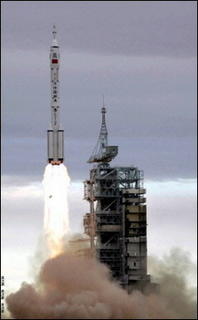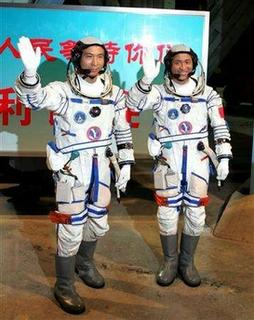
China has launched another manned mission.
Shenzhou VI, based on Soviet Soyuz technology, lifted off on a Long March 2F carrier rocket from Jiuquan Satellite Launch Center at 9:00 am (0100 GMT) for a five-day mission carrying air force pilots Fei Junlong and Nie Haisheng.
It entered a fixed orbit 21 minutes later.
Having two crew on board is a departure from October 2003, when Yang Liwei spent 21 hours on a solo odyssey -- a mission that made China only the third country after the United States and former Soviet Union to send a man into space.
"I feel good," said Fei in his first transmission from the craft.
Fei, 40, and Nie, 41, were seen off by Premier Wen Jiabao, who was at the launch pad to drum up nationalistic sentiment, saying he believed "the astronauts will accomplish the glorious and sacred mission".
"The entire nation has waited, the entire world is watching the success of the Shenzhou VI manned space launch," he said, adding that the "great achievement" would go down "in the annals of the history of the Chinese people".
Amid some concern that China could use space for military purposes, Wen said this was not the case.
"China's entering into the scientific experiment of space flight is entirely for peaceful purposes and is a contribution towards the human race's works in promoting science and peace," he said
Yes, promoting science and peace through rocket launches. Good. We may as well take that at face-value.
There's also this Reuters Report:

BEIJING (Reuters) - China's second manned spacecraft blasted off from a remote northwestern launch site on Wednesday, two years after the country joined an elite club of space powers.
Astronauts Fei Junlong, 40, and Nie Haisheng, 41, both colonels in the People's Liberation Army, were handpicked from 14 fighter pilots and had been in the running for China's first manned space launch in 2003.
"There is nothing to worry about," state television quoted the pair as saying before Shenzhou VI lifted off as a light snow fell. "We will accomplish the mission resolutely. See you in Beijing."
"I feel good," Fei, a native of China's richest city, Kunshan, said minutes after the blast-off from the Jiuquan Satellite Launch Center, deep in the desert of the northwestern province of Gansu.
State television broadcast the lift-off live and showed the pair inside the Shenzhou capsule waving at the camera after the spacecraft entered orbit.
The capsule, based on the Russian Soyuz spacecraft developed in the late 1960s and is still in service, is due to touch down in the remote northern region of Inner Mongolia on Monday.
The launch came just a day after the Communist Party wrapped up a key meeting to map out the development of the world's seventh-largest economy for the next five years. It also came as China opens its 10th National Games, dubbed its mini-OlympicGames, ahead of the Beijing Olympics in 2008.
An elated Premier Wen Jiabao and other leaders were in Jiuquan to witness the launch.
"You will once again show that the Chinese people have the will, confidence and capability to mount scientific peaks ceaselessly," the official Xinhua news agency quoted Wen as telling the astronauts.
China had stressed on Tuesday that its space program was peaceful and it did not want to enter any arms race in space.
SPACE COWBOY
In the Chinese capital, President Hu Jintao and Vice President Zeng Qinghong watched the lift-off at the Beijing Aerospace Command and Control Center.
China is determined to become a serious space player and set up a National Astronaut Training Center in Beijing this week. Xinhua said it was only the third such facility in the world.
"We should never slacken our efforts to explore the mystery of space," Nie, described by Xinhua as a "cowboy," said.
State television has been filled with images of spacecraft and astronauts for the past few days.
China's first man in space was Colonel Yang Liwei, who orbited Earth 14 times aboard Shenzhou V craft in October 2003.
Underlining how far China has to catch up space powers Russia and the United States, a Russian capsule carrying a cosmonaut, a U.S. astronaut and an American space tourist returned to Earth on Tuesday from the International Space Station.
The former Soviet Union and the United States put their first men into space in 1961.
China has had a long -- if not always successful -- relationship with space travel.
The country invented gunpowder and legend has it that a Ming dynasty (1368-1644) official named Wan Hu attempted the world's first space launch. He strapped himself to a chair with kites in each hand as 47 servants lit 47 gunpowder-packed bamboo tubes tied to the seat.
When the smoke had cleared, Wan was apparently found to have been obliterated.
But the dream survived.
(Additional reporting by Guo Shipeng and Judy Hua)
Et cetera, et cetera.
Russian Craft Goes Missing
It turns out that while I've been away watching the playoffs, the Russian Mini-shuttle a.k.a. The Demonstrator went missing.

The Demonstrator spacecraft — designed to carry cargo and passengers from the international space station to Earth — was launched from the submarine Borisoglebsk in the Barents Sea on Friday and was reported to have descended toward its target on time.
Russian news agencies and television, however, later reported that engineers had no communication with the craft and had to call off the search at nightfall.
Officials were not immediately available for comment Saturday.
On Saturday, the Borisoglebsk also conducted a successful test firing of a ballistic missile, hitting a target on Kamchatka, the Defense Ministry said. The Barents Sea is a section of the Arctic Ocean northwest of Russia and north of Norway.
The Demonstrator is intended to be folded up and transported to the international space station on a Russian Progress cargo ship and will be used to bring payloads back to Earth, designers say.
The ship's collapsible, cone-shaped body is made of light material that can withstand high temperatures and it can fly on a predictable trajectory without engines — making it a cheap alternative to the Soyuz spacecraft currently in use.
It was built on contract for the European Space Agency and the European Aeronautic Defence & Space Co., Interfax said.
Sorrt of reminds me of that Thomas Dolby song, 'One Of Our Submarines'.
That wasn't the only launch that went awry for the Russians this week. There was also this launch
MOSCOW - A European Space Agency satellite that was to have collected data on polar ice broke up in flight after being launched on a converted ballistic missile, a Russian space agency official said Saturday.
Remnants of the satellite crashed into the ocean, Vyacheslav Davidenko, a spokesman for the Russian Federal Space Agency, told The Associated Press.
The loss of the CryoSat satellite is a major blow to the agency, which had hoped to conduct a three-year mapping of polar sea ice and provide more reliable data for the study of global warming.
The incident also damaged the reputation of the Russian space agency, which is aggressively trying to move into the commercial satellite launch business. German news reports said the satellite cost an estimated $210 million.
The problem appeared to be with the booster rocket that was supposed to lift the CryoSat unit into orbit, Davidenko said.
"The booster unit did not switch on and it resulted in the failure of the satellite to reach orbit," he said. "The remnants of the satellite have fallen into the northern Arctic Ocean."
"According to preliminary information, it was not a failure of the Space Forces, but the malfunction of the apparatus, which failed in bringing the satellite to orbit," Davidenko said.
Davidenko said the head of the Khrunichev production company, which manufactured the booster unit, apologized to ESA officials for the failure.
Engineers lost contact with the Russian rocket and the satellite some two hours after it blasted off from Russia's northern Plesetsk launch facility at about 7:02 p.m. local time, said Franco Bonacina, a spokesman for the European Space Agency.
He said the satellite was supposed to reach orbit at around 8:30 p.m. — about 1 1/2 hours after launch — but by 8:50 p.m., Russian and European flight controllers had had no contact with it.
"We're trying to figure out exactly what happened," he told the AP by telephone from Plesetsk.
Vikor Remichevsky, deputy director of the Federal Space Agency, was quoted by the ITAR-Tass news agency as saying that there had been "a failure of the navigation system."
The satellite was supposed to spend three years surveying polar ice to help scientists gain a new understanding of global warming.
Equipped with radar altimeters, it was to assess the miles-thick ice sheets that cover Greenland and the Antarctic land mass and the comparatively thin sea ice in the polar regions.
Previous satellites have been able to assess only sea ice.
So the Russian space agency is putting a halt on such launches.
Japan's Mission Problems
In a week of all sorts of launch problems and whatnot (you'd think it was a little bit like erectile problem), here's this news that says the Japanese Space Agency is struggling with their Asteroid Sample-return mission.
PARIS -- Japan's Hayabusa asteroid sample-return spacecraft has lost the use of a second reaction wheel, forcing increased reliance on its chemical-propellant thrusters for attitude control and raising questions about whether it can make its planned asteroid touchdown in November, Japan's Institute of Space and Astronautical Science (ISAS) announced Oct. 4.
Hayabusa, known as MUSES-C before its May 2003 launch, remains in a stable position 6.8 kilometers from its target, the Itokawa asteroid, now 305.9 million kilometers from Earth. Using two reaction control systems with the remaining reaction wheel, the probe is scheduled to continue scouting possible landing sites on Itokawa in the coming weeks.
ISAS said part of the mission -- to take high-resolution pictures of the asteroid -- almost is completed. The mission also has validated the performance of the on-board optical navigation camera, according to ISAS.
Hayabusa ground controllers must now alter their mission profile to conserve fuel burned by the unanticipated use of the reaction control system. The first reaction wheel failed in July. The most recent failure occurred late Oct. 2 Japan Standard Time.
If the original mission scenario is maintained, Hayabusa in November will perform what ISAS calls "touch and go" maneuvers -- briefly landing on the asteroid, scooping up small samples and then taking off -- before beginning its return voyage to Earth, with the samples, in December. Its arrival is scheduled for June 2007.
That doesn't sound too good.

No comments:
Post a Comment